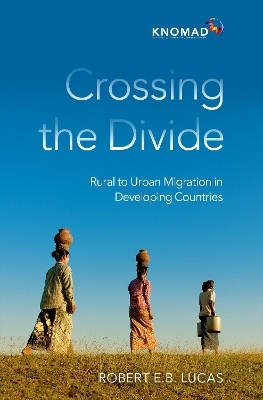
Crossing the Divide
Oxford University Press Inc (Verlag)
978-0-19-760215-7 (ISBN)
Despite the key role of rural-urban migration in structural transformation and the persistence of lower living standards in the countryside, active policies to reduce, or even reverse, movement into towns are common in major developing regions. Climate change is shifting the calculus: the resulting erosion to agricultural opportunities, combined with increasing frequency of natural disasters, is already resulting in substantial population displacement, mostly internally and into towns in particular.
Crossing the Divide examines the nature, causes, and consequences of population movements between the rural and urban sectors of developing countries. Using nationally representative, micro-level data on individuals from seventy-five countries in Africa, the Asia-Pacific, Latin America, and the Caribbean over the course of several decades, Robert E.B. Lucas moves well beyond existing studies to provide the most comprehensive and definitive treatment of internal migration currently available. Lucas analyzes these data on a country-by-country basis, considering both rural-urban and urban-rural movements, to reassess conventional understandings and offer significant new findings on who moves and who stays, the economic incentives and barriers to moving, the role of social networks, return and onward migration, and the impact of migration on families, especially children.
Robert E.B. Lucas is Professor of Economics, Boston University. He is also Research Affiliate at the Center for International Studies, MIT.
Chapter 1: An Introduction and Preview
Chapter 2: Data Sources and Issues in Measurement
2.1. Lifetime Migration
2.2. Interim Moves
2.3. Some Comparisons of Alternative Measurement Approaches
2.4. An Implication: Symmetry or Asymmetry in Moves between Rural and Urban Areas?
Chapter 3: Country-Specific Magnitudes of Migration between Rural and Urban Sectors
3.1. Measurement Results
3.2. The Country-Specific Contexts.
3.3. Closing Remarks
Chapter 4: Who Migrates, Who Stays?
4.1. A Literature Summary
4.2. New Evidence: Characterizing the Movers
Chapter 5: Economic Motives and Barriers to Internal Migration
5.1. Labor Migration: The Individualistic View
5.2. Family Decisions and the New Economics of Labor Migration
5.3. On Barriers to Internal Migration
5.4. Extending the Evidence: Selection and the Returns to Migration and Staying
Chapter 6: The Roles of Social Networks
6.1. Social Networks and Internal Migration: Approaches and Limitations
6.2. Gravity Models and the Dynamics of Cumulative Inertia
6.3. Urban Networks in Rural-Urban Migration: Nationally Representative Estimates
6.4. Exploring Multiple Networks
6.5. Networks at Origin
6.6. A Summing Up
Chapter 7: The Impermanence of Moves: Return and Onward Migration
7.1. Evidence on the Impermanence of Moves
7.2. Return Migration
7.3. Selection and Upward Mobility among Rural-Urban Migrants
7.4. Short-term, Seasonal Migration
7.5. Notes on Repeat and Step Migration
Chapter 8: Impacts of Migration upon Families
8.1. Migrant Departure and the Living Standards of Those Left Behind
8.2 Couples: Cohabitation and Migration
8.3. Migration and the Well-being of Children
Chapter 9: In Perspective: A Summing Up
9.1. Rural-Urban Migration and Urbanization
9.2. The Role of Rural-Urban Migration in Economic Development
9.3. The Incidence and Importance of Temporary Moves
9.4. The Gender Balance in Crossing the Rural-Urban Divide
9.5. Implications for the Structure and Well-Being of Families
9.6. Rural-urban Migration: The Policy Framework
9.7. A Postscript: The COVID Pandemic
Appendix A: Data Sources and Issues in Measurement
Appendix B: Country-Specific Magnitudes of Migration between Rural and Urban Sectors
Appendix C: Who Migrates, Who Stays?
Appendix D: Economic Motives and Barriers to Internal Migration
Appendix E: The Roles of Social Networks
Appendix F: The Impermanence of Moves: Return and Onward Migration
Appendix G: Impacts of Migration upon Families
References
| Erscheinungsdatum | 06.09.2021 |
|---|---|
| Verlagsort | New York |
| Sprache | englisch |
| Maße | 246 x 165 mm |
| Gewicht | 1066 g |
| Themenwelt | Naturwissenschaften ► Geowissenschaften ► Geografie / Kartografie |
| Sozialwissenschaften ► Soziologie | |
| Wirtschaft ► Volkswirtschaftslehre ► Makroökonomie | |
| ISBN-10 | 0-19-760215-0 / 0197602150 |
| ISBN-13 | 978-0-19-760215-7 / 9780197602157 |
| Zustand | Neuware |
| Haben Sie eine Frage zum Produkt? |
aus dem Bereich


